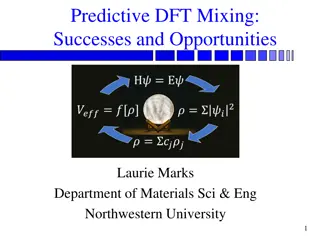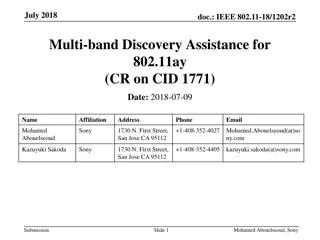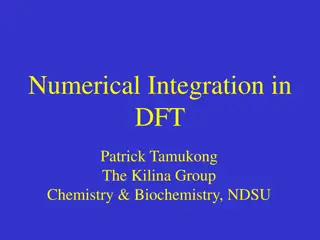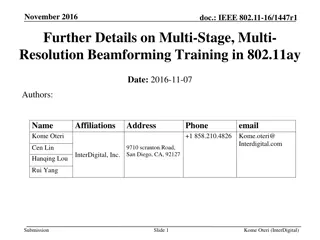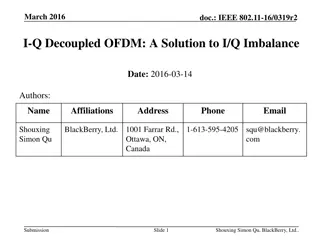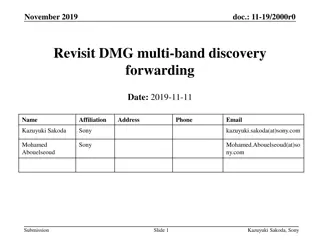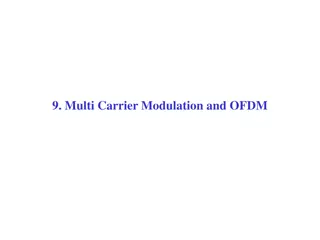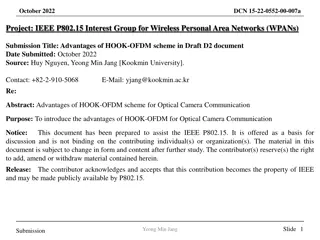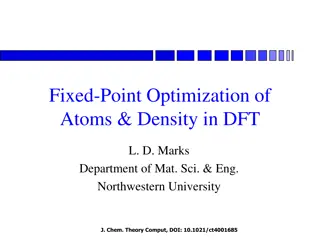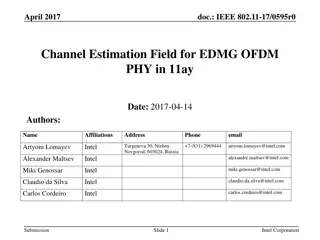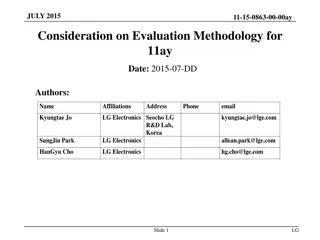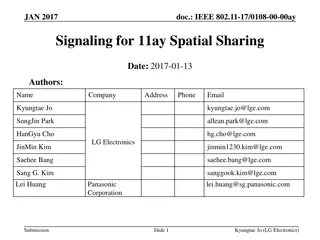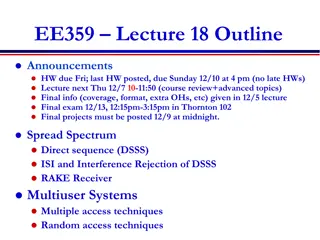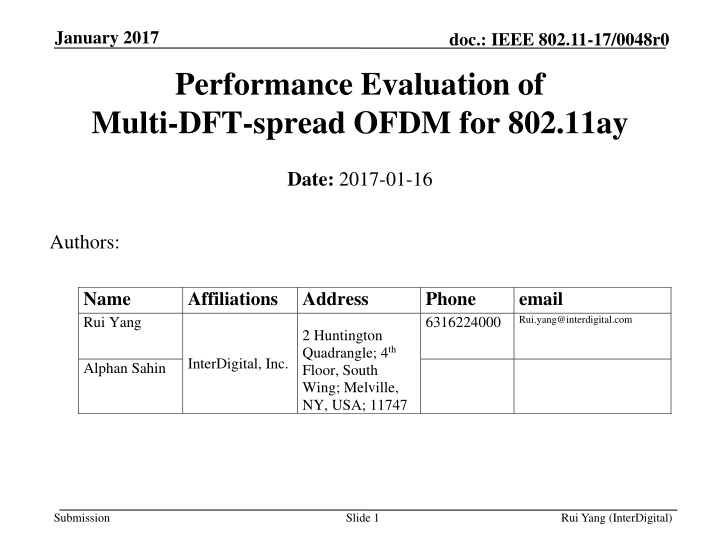
Performance Evaluation of Multi-DFT-Spread OFDM for 802.11ay
Explore the benefits of a waveform with multi-DFT-spread operation for 802.11ay to address hardware impairments in wideband channels. Compare the waveform with SC and CP-OFDM through simulation results. Learn about the advantages in dealing with high PAPR, achieving orthogonal FDMA, and compensating for ICI. Discover how multi-DFT-spread OFDM can improve coverage range and enhance receiver capabilities in 60 GHz channels.
Download Presentation

Please find below an Image/Link to download the presentation.
The content on the website is provided AS IS for your information and personal use only. It may not be sold, licensed, or shared on other websites without obtaining consent from the author. If you encounter any issues during the download, it is possible that the publisher has removed the file from their server.
You are allowed to download the files provided on this website for personal or commercial use, subject to the condition that they are used lawfully. All files are the property of their respective owners.
The content on the website is provided AS IS for your information and personal use only. It may not be sold, licensed, or shared on other websites without obtaining consent from the author.
E N D
Presentation Transcript
January 2017 doc.: IEEE 802.11-17/0048r0 Performance Evaluation of Multi-DFT-spread OFDM for 802.11ay Date: 2017-01-16 Authors: Name Rui Yang Affiliations Address 2 Huntington Quadrangle; 4th Floor, South Wing; Melville, NY, USA; 11747 Phone 6316224000 email Rui.yang@interdigital.com InterDigital, Inc. Alphan Sahin Submission Slide 1 Rui Yang (InterDigital)
January 2017 doc.: IEEE 802.11-17/0048r0 Abstract In [1], a waveform with multi-DFT-spread operation was introduced for 802.11ay to support SU and orthogonal MU transmissions over wideband channels to address hardware impairments, i.e., non-linear power amplifier and phase noise to exploit channel selectivity in 60 GHz channels In this contribution, we demonstrate those benefits of this waveform via simulation results and compare it with single carrier (SC) and CP-OFDM Submission Slide 2 Rui Yang (InterDigital)
January 2017 doc.: IEEE 802.11-17/0048r0 Introduction (1/2) TGay has agreed that [2] 11ay shall enable both SC and OFDM waveforms for SU-MIMO and MU-MIMO data transmission and support multiple STAs allocated to different frequency resources in downlink The bandwidth of bonded channels can be up to 8.64GHz For very wide BW transmission, the PAPR for OFDM can be very large. While SC maintains lower PAPR, Using matched filter at receiver is a suboptimum solution in selective channels It is not trivial how to achieve orthogonal FDMA with SC SC cannot exploit the frequency selectivity as OFDM does The channel characteristics at 60 GHz can vary significantly, depending on beamforming at TX and RX, existence of line-of- sight (LoS), and environment The maximum delay spread can be as large as several hundreds of ns due to rich non-line-of-sight (NLoS) paths [3][4], especially in outdoor scenarios, or very low in LoS scenarios Slide 3 Submission Rui Yang (InterDigital)
January 2017 doc.: IEEE 802.11-17/0048r0 Introduction (2/2) In [1], it is shown that multi-DFT-spread OFDM can address the shortcomings of SC and OFDM Use of multi-DFT-s OFDM can lead to much lower PAPR than that of OFDM for wide band channels. This translates to increased coverage range for 802.11ay [5-9] Multi-DFT-spread OFDM allows receiver to exploit the frequency selectivity and enable orthogonal FDMA for MU transmitter Use of multi-DFT-s OFDM can facilitate the compensation of ICI due to the phase noise correction at receiver The guard interval with multi-DFT-spread OFDM can be adjusted by changing the length of the sequence without affecting the block duration [5-9] multi-DFT-spread ? Data symbols DFT (M) Mapp ing ? samples Golay sequence P / S IDFT (N) Data Symbols Golay S. RF ? Data symbols DFT (M) Mapp ing ?th block Golay sequence ? Submission Slide 4 Rui Yang (InterDigital)
January 2017 doc.: IEEE 802.11-17/0048r0 PAPR results with multi-DFT-s OFDM ?is the number of DFT-spread blocks With multiple DFT-spread blocks, the PAPR is still lower than that of OFDM Simulation assumptions are given in Appendix I ?1 DFT IDFT ?? DFT Submission Slide 5 Rui Yang (InterDigital)
doc.: IEEE 802.11-17/0048r0 Reducing PAPR Further with Frequency Domain Windowing Golay sequence Data symbols Data symbols Golay sequence Output of DFT (M) (a) DFT (M) DFT (M) ? (a) (a) Extending Extending (b) (b) (b) ? Windowing Windowing (c) (c) (c) IDFT (N) ? DFT-spread operation is compatible with low-complexity PAPR reduction methods In [10, 11], it is shown that the PAPR can be reduced further if the output of DFT is extended cyclically (b) and the extended block is windowed (c) This operation changes the sinc kernel of DFT-spread OFDM DFT-spread OFDM receiver can exploit the energy on the extended bands with coherent additions (see Appendix III) Submission Slide 6 Rui Yang (InterDigital)
January 2017 doc.: IEEE 802.11-17/0048r0 PAPR Results with Frequency Domain Windowing The results show that frequency domain windowing (i.e., DFT-s Windowed OFDM) reduces PAPR of DFT-spread OFDM further, even for 64 QAM Windowing functions are provided in Appendix II ?1 Ext. & Win. DFT IDFT ?? Ext. & Win. DFT Submission Slide 7 Rui Yang (InterDigital)
doc.: IEEE 802.11-17/0048r0 Spectrum Results Multi-DFT-spread OFDM jointly reduces the out-of-band (OOB) leakage and PAPR as compared to CP-OFDM without applying extra operation Frequency domain windowing also reduces the OOB emission Submission Slide 8 Rui Yang (InterDigital)
January 2017 doc.: IEEE 802.11-17/0048r0 Throughput Results (1/3) Assumptions Fixed location and orientation 1.5 m AP AP 0.5 m PPA 2.9 m STA 1 m 3 m 1 m PPA 1 m Random location and orientation STA 4.5 m Channel: 11ay channel model, conference room, STA-AP The location of the STA and the rotation of the PAA around vertical axis are chosen randomly. For each drop, the boresight of the STA and AP antenna patterns are aligned on LoS Vertical polarization, LoS path exists Numerology: The 8 GHz numerology for CP-OFDM and SC is obtained based on 802.11ad The numerology for DFT-spread OFDM is obtained based on 11ad CP-OFDM Details are provided in Appendix I Equalization: Single tap MMSE-FDE CHEST: Ideal Impairments: None Submission Slide 9 Rui Yang (InterDigital)
January 2017 doc.: IEEE 802.11-17/0048r0 Throughput Results (2/3) Channel a) Normalized channel impulse response b) Channel frequency response The selectivity of the channel significantly reduces when there is ? ? PAA at AP and ? ? for the channel model considered in the simulation and beam alignment This implies that the OFDM will not bring extra gain due to the channel selectivity Submission Slide 10 Rui Yang (InterDigital)
January 2017 doc.: IEEE 802.11-17/0048r0 Throughput Results (3/3) Simulation (8 GHz BW) a) 8 1 PAA @ AP, 1 1 PAA @ STA b) 8 2 PAA @ AP, 2 2 PAA @ STA SC is worse than CP-OFDM and DFT-spread OFDM as the matched filtering loses its optimality in selective channels When the channel is selective, CP-OFDM is better than DFT-spread OFDM and SC OFDM as it maximally resolves the channel in frequency. The price is high PAPR. Under the practical PAA settings, i.e., case (b), there is little difference between DFT- spread OFDM and OFDM performance The windowing operation approximately provides the same performance with the case without windowing Slide 11 Submission Rui Yang (InterDigital)
January 2017 doc.: IEEE 802.11-17/0048r0 Conclusion In this contribution, we compare the use of multi-DFT-spread OFDM with CP-OFDM and SC The simulation results show that the DFT-spread OFDM achieves approximately the same throughput performance of CP-OFDM while jointly reducing PAPR and OOB substantially DFT-spread OFDM also allows low complexity PAPR reduction techniques, e.g., frequency domain windowing For further investigation Outdoor channel model for 802.11ay needs to be developed RF impairments, including phase noise, should be included Welcome to any suggestion (e.g., numerology) for further evaluation of this method Submission Slide 12 Rui Yang (InterDigital)
January 2017 doc.: IEEE 802.11-17/0048r0 References [1] On the Single Carrier Waveforms for 11ay , IEEE 802.11-15/01455r0 [2] Specification Framework for TGay, IEEE 802.11-15/01358r6 [3] Channel Models for IEEE 802.11ay, IEEE 802.11-15/1150r7 [4] Outdoor measurement for a rooftop to street scenario at 60 GHz, IEEE 802.11-16/1221r0 [5] G. Berardinelli, et.al., Zero-tail DFT-spread-OFDM signals, Globecom 2013 Workshop - Broadband Wireless Access [6] U. Kumar, et.al., A Waveform for 5G: Guard Interval DFT-s-OFDM, 2015 IEEE Globecom Workshops (GC Wkshps) [7] F. Hasegawa, et.al., Static Sequence Assisted Out-of-Band Power Suppression for DFT-s-OFDM, Proc. IEEE 26th Annual International Symposium on Personal, Indoor, and Mobile Radio Communications (PIMRC), Hong Kong, 2015, pp. 61-66. [8] A. Sahin, et.al., An Improved Unique Word DFT-Spread OFDM Scheme for 5G Systems, 2015 IEEE Globecom Workshops (GC Wkshps) [9] G. Berardinelli, K. I. Pedersen, T. B. Sorensen and P. Mogensen, "Generalized DFT-Spread-OFDM as 5G Waveform," in IEEE Communications Magazine, vol. 54, no. 11, pp. 99-105, November 2016. [10] Stefania Sesia, Issam Toufik, and Matthew Baker, The UMTS Long Term Evolution: From Theory to Practice Wiley Publishing, 2009 [11] A. Sahin, R. Yang, E. Bala, M. C. Beluri and R. L. Olesen, "Flexible DFT-S-OFDM: Solutions and Challenges," in IEEE Communications Magazine, vol. 54, no. 11, pp. 106-112, November 2016. Submission Slide 13 Rui Yang (InterDigital)
January 2017 doc.: IEEE 802.11-17/0048r0 Appendix I Numerology (8 GHz) # of Guard Tones (left) # of Guard Tone (Right) # of data symbol s Utilized spectral resources (GHz) ? =?? DFT- spread size Extens ion on edges # of DFTs (K) Total Head size Total Tail Size Block Duration (ns) Data rate (BSPK) (Gbps) Spectral Efficiency IFFT Size N DC tones # of pilots Waveform CP Size ? (kHz) CP OFDM 2048 318 319 -1,0,1 - - 4 256 64 - - 5156.25 1344 218.18 6.1601 7.2755 0.8467 DFT-s OFDM (K=1) 2048 352x4 - 1 0 - 24 160 5156.25 1226 193.94 6.3215 7.26 0.8707 320 320 - DFT-s OFDM (K=2) 2048 352x2 - 2 0 - 24 160 5156.25 1226 193.94 6.3215 7.26 0.8707 320 320 - DFT-s OFDM (K=4) 2048 352x1 - 4 0 - 24 160 5156.25 1226 193.94 6.3215 7.26 0.8707 320 320 - DFT-s W OFDM (K=1) DFT-s W OFDM (K=2) DFT-s W OFDM (K=4) 352x4 140 1 0 - 24 160 5156.25 1226 193.94 6.3215 8.70 0.7267 2048 180 180 - 352x2 70 2 0 - 24 160 5156.25 1226 193.94 6.3215 8.70 0.7267 2048 180 180 - 352x1 35 4 0 - 24 160 5156.25 1226 193.94 6.3215 8.70 0.7267 2048 180 180 - Corresponds to Approximately 266 samples in time for guard interval SC 1792 290.91 6.1600 8.45 0.7267 Windowing functions are provided in the next slide Waveform Block Size Upsampling Downsampling Roll-off factor SC 2048 3 1 0.2 Submission Slide 14 Rui Yang (InterDigital)
November 2016 doc.: IEEE 802.11-17/0048r0 Appendix II Windowing Functions Raised cosine function is considered for the edge of the windowing function Submission Slide 15 Rui Yang (InterDigital)
January 2017 doc.: IEEE 802.11-17/0048r0 Appendix III The DFT-spread Windowed OFDM Receiver CFR (includes the impact of windowing) S / P DFT (N) Weight and sum P / S RF Correct phases IDFT (M) Symbols MMSE Coherent addition ? ? + + Submission Slide 16 Rui Yang (InterDigital)
January 2017 doc.: IEEE 802.11-17/0048r0 Appendix IV PAPR for QPSK Submission Slide 17 Rui Yang (InterDigital)
January 2017 doc.: IEEE 802.11-17/0048r0 Appendix V Throughput Results (4 GHz BW) a) 8 1 PAA @ AP, 1 1 PAA @ STA b) 8 2 PAA @ AP, 2 2 PAA @ STA Submission Slide 18 Rui Yang (InterDigital)
January 2017 doc.: IEEE 802.11-17/0048r0 Straw Poll (for survey) Do you agree that the TGay should further study the feasibility of including multi-DFT-spread OFDM as an additional waveform for 11ay? Submission Slide 19 Rui Yang (InterDigital)

